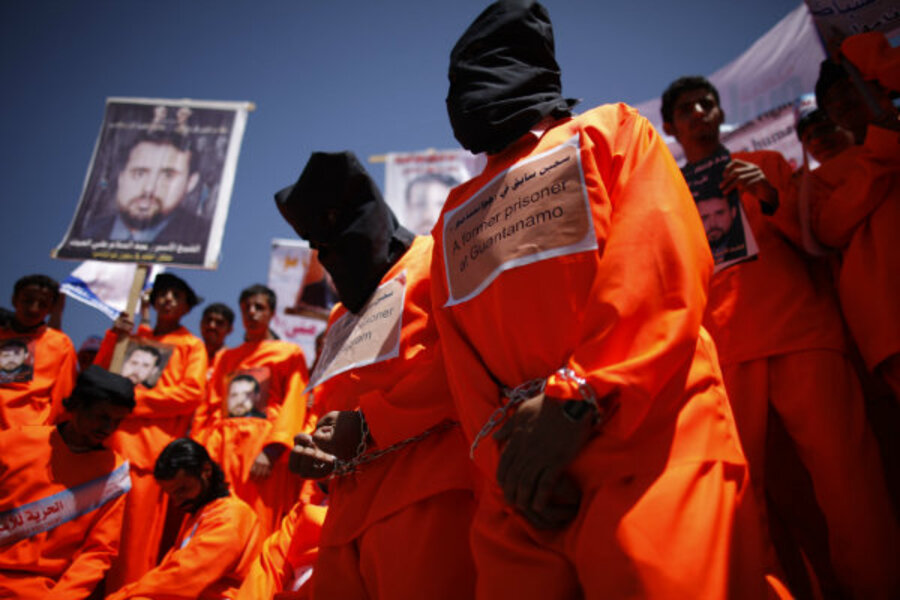America can't afford the real cost of Guantánamo
Loading...
| Washington
In his April 30 press conference, President Obama responded to a reporter's question about the hunger strikers at Guantánamo with a promise to reengage with Congress to close the US detention facility in Cuba. While that is encouraging news after his five years of relative silence on the subject, it doesn’t go far enough. In fact, Mr. Obama’s policies have allowed the injustice at Guantánamo to continue.
Americans can not afford the cost of inaction any longer: Guantánamo serves as a recruitment tool for Al Qaeda. It threatens America's global standing as a beacon of justice and the rule of law. And it undermines the international legal precedents that would protect US prisoners abroad as well.
It’s high time for Obama to take action on Guantánamo. Its prisoners must be released or charged and tried and the facility closed. With some hunger-striking prisoners reportedly near death, the matter is urgent.
The facts speak for themselves. Of the 166 current “detainees” in Guantánamo, relatively few of them are actually accused terrorists awaiting trial. Eighty-six have been cleared for release to their home countries or other nations willing to accept them. But the Obama administration stalled the transfers in 2009 over concerns about instability in Yemen. Beyond that, a total of 46 detainees have not been charged with any crime and are approved for indefinite detention.
A decade-long detention without end in sight has given rise to hopelessness and despair among the inmates. One hundred of the 166 detainees are now reportedly on a hunger strike. In an effort to suppress the strike, prison authorities have punished participants with forced-feeding (21 of them), lockdowns, and solitary confinement.
Guantánamo also comes at a high price to American taxpayers, costing them $177 million per year. That's an annual cost of more than $1 million per prisoner. Now the military is requesting another $200 million for prison renovation.
Defenders of Guantánamo argue against releasing any prisoners, even those determined to be without connection to Al Qaeda or other terrorist groups. As part of Defense spending bills, Congress has routinely passed amendments barring the transfer of Guantánamo detainees to US prisons. Amendment supporters argue that these individuals post a grave threat to US safety, are enemy combatants, and should not be held in civilian prisons or tried in civilian courts.
Some have raised concerns about the ability of federal civilian courts to adequately mete out justice for accused terrorists. But the Department of Justice has successfully handled more than 1,000 terror trials, with a more than 90 percent conviction rate.
In the name of national security, Guantánamo defenders would have the US government continue to violate the international legal standards and conventions that America helped create after the Second World War.
It would be no surprise if prisoners who have been tortured and indefinitely detained by the US for more than a decade rallied to America's enemies upon their release. However, it's unclear how many released Guantánamo prisoners have actually joined militant groups.
The Defense Department said in 2009 that 18 released detainees are “confirmed” and 43 are “suspected” to have participated in subsequent terror attacks after their release from Guantánamo. But members of the media and other observers have challenged the reliability of those numbers on several grounds.
Some have pointed to flaws in the Pentagon’s criteria for “confirming” and “suspecting” terrorist involvement. Others have noted inconsistencies in the names of those held at Guantánamo compared with those listed as returning to terrorism after release – attributed to confusion over similar, common Muslim names.
Whatever the risk of released prisoners “returning to the battlefield,” it would seem outweighed by the more obvious risk that Guantánamo poses: It serves as a recruitment poster for Al Qaeda. The assessment of security risks must also take into account the ongoing damage to America's moral standing in the world – damage that will greatly increase if and when the Guantánamo hunger strikers start dying from their fast.
An even more significant long-term cost may be the potential for blowback from legal precedents being set by the Guantánamo prison and the harsh treatment of its prisoners. Such precedents not only undermine global respect for international human rights and the rule of law, but also create a hostile legal environment for Americans who may someday find themselves incarcerated by an enemy force.
While Americans naturally want to minimize the risk of another 9/11, we need to ask ourselves whether the indefinite detention of prisoners, most of whom were rounded up in response to US bounty offers, will really enhance our national security – or impair it.
We should question whether our security needs, as assessed today, trump the traditional American values of justice and the rule of law. Only a lawless society would condone indefinite detention, forced-feeding, and solitary confinement.
As taxpayers, we should ask ourselves whether Guantánamo is worth the hundreds of millions of dollars it has already cost – and will cost if the prison is renovated, as the US military recommends.
The National Defense Authorization Act allows Obama to transfer prisoners out of Guantánamo in the interest of US security. He must exercise that authority to release the prisoners who have no legal case against them – hopefully in time to quell the hunger strike. And notwithstanding the objections of Congress, Obama should announce that the other detainees will be brought to the US for trial. Lastly, he must enforce his executive order of 2009 by closing the Guantánamo prison forever.
The consequences of ignoring Guantánamo, its abuses, and its hunger strikers are foreboding – for the prisoners and for America.
L. Michael Hager is co-founder and former director general of the International Development Law Organization in Rome.





